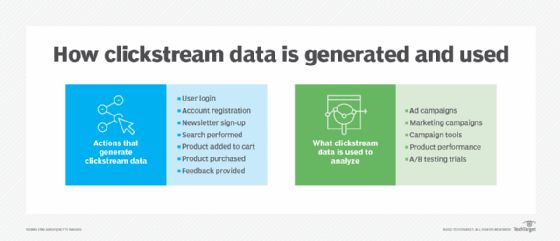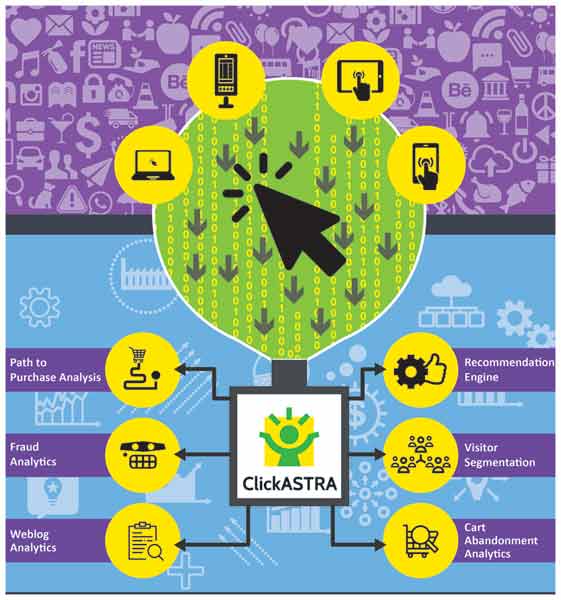Unlock the secrets of user behavior with clickstream data analysis. Discover how every click can reveal valuable insights for marketers.

Image courtesy of via DALL-E 3
Table of Contents
Introduction to Clickstream Data
Welcome to the exciting world of Clickstream Data! Have you ever wondered how websites keep track of the things you click on and the pages you visit? Well, that’s where Clickstream Data comes into play. In this section, we will explore what Clickstream Data is and why it is essential for understanding user behavior.
What is Clickstream Data?
Clickstream Data is like a digital breadcrumb trail of your online activities. It records every click you make while browsing a website, showing the path you take from one page to another. Imagine it as a map that reveals the route you follow on the internet. This data helps businesses understand how users interact with their websites, making it a valuable tool for improving online experiences.
Why Clickstream Data Matters
Clickstream Data is crucial for businesses and websites because it provides valuable insights into user behavior. By analyzing this data, companies can better understand what users like and dislike, how they navigate through a website, and where they may encounter problems. This information allows businesses to make informed decisions to enhance their services and create a more user-friendly experience.
How Clickstream Data is Collected
When it comes to collecting clickstream data, there are various methods and tools used to track and record user activity on websites. By understanding how this data is collected, businesses can gain valuable insights into user behavior and preferences, allowing them to make informed decisions to enhance their services. Let’s delve into the ways clickstream data is gathered:
Web Server Logs
One of the primary methods of collecting clickstream data is through web server logs. These logs automatically record details of each visit to a website, including the pages visited, timestamps, referring websites, and user interactions. Essentially, web server logs act as a digital trail of a user’s journey through a website, providing valuable information on user behavior and preferences.
Tracking Codes
Another common method used to collect clickstream data is through tracking codes embedded within websites. These codes capture user actions such as clicks, scrolls, and form submissions, allowing businesses to track and analyze user interactions in real-time. By deploying tracking codes strategically across a website, businesses can gain a comprehensive understanding of how users engage with their content and services.
Components of Clickstream Data
One of the key components of clickstream data is the record of the pages a user visits while navigating a website. Every time you click on a link or access a new page, that action is recorded. This information is important because it helps businesses understand which pages are most popular and where users spend their time.

Image courtesy of www.techtarget.com via Google Images
Time Spent on Pages
Another important aspect of clickstream data is how long users spend on each page they visit. By tracking the time spent on a page, businesses can determine which content is engaging and which may need improvement. For example, if users quickly leave a page, it could indicate that the content is not meeting their needs.
Clicks and Actions
In addition to recording the pages visited and time spent on them, clickstream data also tracks user actions such as clicks on specific links, buttons, or other interactive elements on a website. Analyzing these clicks and actions can provide insights into user behavior, preferences, and intentions. For example, businesses can see which call-to-action buttons are most effective in driving conversions.
Analyzing Clickstream Data
When we talk about analyzing clickstream data, we are exploring the process of uncovering patterns and trends in how users interact with websites. By studying this data, businesses can gain valuable insights into user behavior and make informed decisions to enhance their online platforms.
Identifying Popular Paths
One of the key aspects of analyzing clickstream data is identifying the most popular paths that users take through a website. By tracking the sequence of pages visited and actions taken, businesses can understand which routes are commonly followed by users. This information can help optimize the website layout and content to cater to user preferences and encourage further exploration.
Spotting Drop-off Points
Another critical element of analyzing clickstream data is spotting drop-off points on a website. These points indicate where users are leaving the site, which can highlight potential issues such as confusing navigation or unappealing content. By pinpointing these areas of high exit rates, businesses can focus on improving those specific pages to retain users and enhance the overall user experience.
Using Clickstream Data to Improve Websites
One way businesses can use clickstream data to make their websites better is by enhancing navigation. Navigation refers to how users move around a website. By analyzing the paths users take through a site, businesses can identify bottlenecks or confusing points that may be hindering a smooth user experience. With this data, companies can make changes to the layout or structure of their websites to make it easier for users to find what they are looking for.
Image courtesy of prominentpixel.com via Google Images
Content Optimization
Another way to improve websites using clickstream data is through content optimization. This involves adjusting the content on a website to better meet the needs and interests of users. By analyzing which pages users spend the most time on or which articles they click on the most, businesses can tailor their content to be more engaging and relevant. This can lead to increased user satisfaction and retention on the site.
Privacy and Ethical Considerations
As we explore the fascinating world of clickstream data and the insights it provides into user behavior, we must also take a moment to consider the importance of privacy and ethical considerations in the use of this data. Respecting user privacy and applying ethical practices are fundamental principles that should guide businesses and websites in handling clickstream data.
Data Privacy
Protecting users’ privacy should be a top priority when collecting and analyzing clickstream data. Users entrust websites with their information as they navigate through pages, and it is essential to safeguard this data from unauthorized access or misuse. Implementing robust security measures, such as encryption and data anonymization, can help ensure that users’ personal information remains confidential.
Ethical Use of Data
Using clickstream data ethically involves a commitment to transparency, accountability, and honesty in how the data is utilized. Businesses must be clear with users about the information they are collecting and how it will be used. Additionally, it is crucial to use the data in ways that benefit users, such as improving website usability or customizing content to enhance the user experience. Respecting user preferences and providing options for controlling their data can also contribute to the ethical use of clickstream data.
Real-World Examples of Clickstream Data Use
Let’s talk about how online stores make use of clickstream data to boost their sales. Imagine you are shopping online for a new pair of sneakers. As you browse through different options, the e-commerce website is silently observing your every move. It records which sneakers you looked at, how long you spent on each product page, and whether you added anything to your cart.

Image courtesy of www.happiestminds.com via Google Images
This data is incredibly valuable for the online store. By analyzing your clickstream data, the website can understand your preferences and behavior. It can then use this information to recommend similar products, send you personalized offers, or even create targeted advertisements. This personalized approach can significantly enhance your shopping experience and increase the chances of you making a purchase.
Content Websites
Now, let’s shift our focus to how media websites utilize clickstream data to keep their readers engaged. Imagine you are reading an article on a news website. As you scroll through the article, the website is silently tracking your every move. It knows which sections you linger on, which articles you click on next, and how long you spend reading each piece.
This data is crucial for content websites to understand what readers are interested in and how they consume information. By analyzing clickstream data, these websites can tailor their content to better suit the preferences of their audience. They can showcase related articles, adjust the layout for better readability, and even personalize the content based on individual reading habits. This personalized approach can help keep readers engaged and coming back for more.
Conclusion
After exploring the world of clickstream data and its implications for understanding user behavior, it’s clear that this form of data analysis is crucial for businesses looking to improve their services and enhance user experiences. By tracking the pathway users take through a website, businesses can gain valuable insights into how to optimize their online platforms.
Recap of Clickstream Data Benefits
Clickstream data provides businesses with a detailed picture of user behavior, including the pages visited, time spent on each page, and specific actions taken. By analyzing this data, companies can identify popular paths, spot drop-off points, and make informed decisions to enhance website navigation and content.
Future of Clickstream Data
As technology continues to advance, the future of clickstream data analysis looks promising. New tools and methods for collecting and analyzing data are constantly being developed, allowing businesses to delve even deeper into user patterns and trends. With the ongoing evolution of clickstream data analysis, businesses will have access to even more powerful insights to drive their decision-making processes.
Want to turn these SEO insights into real results? Seorocket is an all-in-one AI SEO solution that uses the power of AI to analyze your competition and craft high-ranking content.
Seorocket offers a suite of powerful tools, including a Keyword Researcher to find the most profitable keywords, an AI Writer to generate unique and Google-friendly content, and an Automatic Publisher to schedule and publish your content directly to your website. Plus, you’ll get real-time performance tracking so you can see exactly what’s working and make adjustments as needed.
Stop just reading about SEO – take action with Seorocket and skyrocket your search rankings today. Sign up for a free trial and see the difference Seorocket can make for your website!
FAQs
What is Clickstream Data?
Clickstream data is like a trail of breadcrumbs that shows the path a person takes when they click on things while using a website. It helps businesses understand how people move around their site.
How is Clickstream Data Used?
Businesses use clickstream data to see what people do on their websites. They can find out which pages are popular and where people might be getting stuck. This information helps them make their websites better for users.
Is Clickstream Data Collection Safe?
Clickstream data collection is generally safe because it doesn’t usually include personal information like names or addresses. Companies should follow strict rules to protect user privacy and make sure data is used responsibly.







